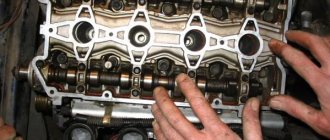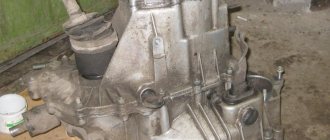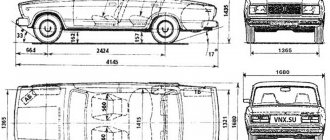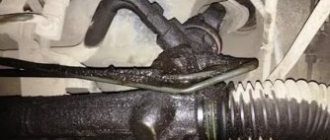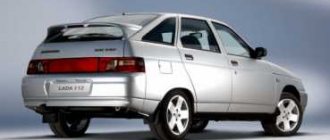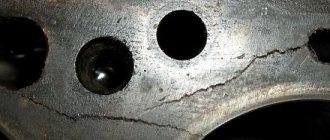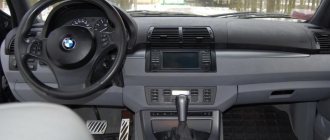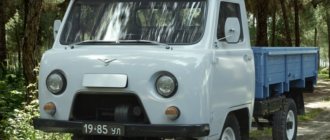09.08.2018
A properly functioning crankshaft bed is the key to normal rotation and trouble-free operation of the engine. Among the most common problems that push car owners and mechanics to repair work are problems with the crankshaft bed. In fact, the crankshaft bed is a complex product with a rounded geometric shape. Problems are deviations in cross-sectional shapes to the surface of the circle in cylindrical engine parts.
Wear of crankshaft beds
The crankshaft in the cylinder block is installed by the main journals in special seats - they are called “crankshaft main supports” and look like this:
In the supports of the crankshaft main journals, liners are installed on which the crankshaft is placed:
The crankshaft main journals are closed from above with covers, into the seats of which liners are also installed:
This is what the crankshaft looks like installed in the cylinder block:
Schematically, the crankshaft main journal installed in the cylinder block looks like this:
In this design, there is virtually no metal-to-metal friction - between the surfaces of the liners and the crankshaft journal there is an oil wedge - an oil film that occurs due to the supply of oil under pressure. Oil is supplied through holes drilled in the crankshaft and bearings specifically for this purpose. Despite this, in any engine the liners wear out over time, that is, they become thinner. Because of this, the gap between the liner and the crankshaft journal increases. This leads to a decrease in oil pressure, and as a result, to an increased load on the liner itself and on the crankshaft bed. Ultimately, not only the crankshaft bearing and journal wear out, but also the crankshaft bed. In extreme, emergency cases, the liner rotates in the seat, it blocks the oil supply hole, and all parts located further along the oil supply line begin to suffer from oil starvation. But the seat immediately suffers from rotation of the liner, and quite significantly.
Schematic representation of a worn-out unit:
And this is how the crankshaft main support looks schematically after the crankshaft and liner are removed:
The actual wear of the support looks, for example, like this:
And this is what wear in the cover might look like:
Frequently occurring defects
The most common defect of cylindrical surfaces is the deviation of their cross-sectional shape from the circle, manifested in the form of ellipse.
There are various reasons. Elliptical bores can occur as a result of normal but prolonged engine operation. Then there is an almost identical increase in the diameters of all holes in comparison with the nominal value. Moreover, the least rigid parts of the support—the main caps—are deformed. This is typical for most engines with cast iron blocks. For engines with blocks made of light alloys, after a run of 200-300 thousand km, a different picture is revealed. The ellipse of the bed holes is formed by increasing their size in the plane of the separation of the block supports with the main covers. As a rule, the difference in diameters measured in the plane of the support connector and perpendicular to it can be up to 0.05 mm. Ellipticality of the bed holes can be observed at low mileage as a result of a violation of the lubrication regime of the main bearings . The initial stage of the process is accompanied by a sharp increase in temperature in the contact zone of the journal and liner, which leads to heating of the shaft bed, which is in direct contact with the bearings. As a result, the structural elements of the shaft supports are weakened, primarily bolts and covers. In this case, the geometry of the hole in the support is disrupted.
Engines with a light alloy cylinder block also suffer from overheating. In them, the shape of the bed holes is distorted mainly due to changes in the geometry of the aluminum parts of the supports.
Serious damage to the bed surfaces occurs when an increase in temperature in the friction zone of the journal with the bearing leads to complete melting of the antifriction layer and “sticking” of the liner. Rotating the liner causes rapid abrasion of the supporting surfaces of the neck. More often, one of the supports is damaged, having the worst lubrication conditions.
What will happen if the crankshaft bed is not restored?
In principle, if there is damage to the crankshaft bed, it is possible not to do anything with it - just install new bearings, grind the crankshaft to the repair size if necessary (or install a new one), and assemble the engine. But this is bad, and here's why:
- When changing the geometry of the beds, there is a very high probability that the alignment of the main supports will be disrupted. In the best case, it will be so broken that after assembly the crankshaft will not rotate. This is a good option, since in this case the problem will be immediately obvious and will have to be solved one way or another. Otherwise, the engine will start and run, but it will most likely not run for long.
- Even if the alignment is not broken, the problem of a large gap between the liner and the supports will remain. This will lead to poor lubrication of the unit, which in turn will lead to accelerated wear and the need for repeated repairs.
Restoring resolves both problems. The required dimensions of the supports are the main goal of the work, and alignment is ensured by restoration technology.
Thus, the “do not restore” option, although feasible in principle, does not make sense in practice - unless, of course, the goal is to collect the maximum practical knowledge about non-compliance with repair technology. As a rule, the engine is repaired in order to drive, so we can conclude that it is necessary to repair the crankshaft beds if they are damaged.
How to profitably exchange a used car
To guarantee the legality of the used car exchange service and its objective cost, the purchase and sale process should be carried out at a trusted auto center. Here the client will be offered:
- Diagnostics of the old model, on the basis of which its cost will be determined;
- Selection of cars for exchange, completely new or with a clean mileage history: all cars undergo forensic examination, therefore the car dealership will never sell a car with a “dark past”;
- Legal support of the transaction: the client enters into a notarized agreement and, if necessary, can use the credit services of the car dealership’s partner bank;
- Efficiency of the service: the client does not need to look for buyers for his vehicle; he does not need to settle issues with the traffic police or the bank. The listed functions are the task of the auto center.
Thus, with minimal documents, it is possible to buy an improved car within one to three days. The used car exchange service makes it possible to regularly change the owner’s vehicle fleet by purchasing its best models.
Methods for repairing crankshaft beds
There are quite a lot of repair technologies; the specific technological route depends on the specific engine and its condition, but we will describe the general methodology.
The first thing you need to understand when faced with the task of restoring crankshaft beds is whether there are liners of repair sizes for a given engine, for the increased diameter of the bed. If yes, and the wear of the beds does not exceed these dimensions, then all that remains is to grind the beds to the repair size. The specific technique will be described below.
If there are no repair inserts, a boring of the nominal size remains. It is also possible that the beds are so worn out that boring to the repair size is no longer possible - in this case, additional metal is applied (spraying, welding), which is bored to the required size.
In any case, boring is done on a horizontal boring machine, similar to the one shown in the photo below, but different restoration technologies are used.
Boring to nominal size with lowering of main bearing caps
In this case, about 0.5 mm is removed (depending on the specific case) from the plane where the crankshaft bed cover adjoins the mating part. After this, the covers are installed in their regular places. After this, the bed becomes elliptical, which means it can be cut to the required size.
The sketch shows a lowered cover installed on the main support. The amount of underestimation is exaggerated for clarity:
A clear advantage of this method is the restoration of the nominal size and the use of standard liners. The downside is that the crankshaft axis shifts, and with a large displacement this can be critical for engine operation. As a rule, after measuring the wear of the crankshaft beds, it becomes clear by what amount the caps will have to be lowered and how much the axle will move. Based on this, a conclusion is drawn whether this method is suitable for this particular case.
The sketch shows the crankshaft bed, restored with the cover lowered. Displacement of the crankshaft axis is noted:
This method is not suitable; the engine design uses “explosive” support covers, which are made by the “breaking off” method. In this case, the contact surface of the covers with the bed is uneven. It would have to be lowered by several millimeters, and this would lead to a critical change in the engine geometry, incompatible with its performance.
The photo shows the mating of the cover and the seat:
This is what the mating part looks like:
What kind of crankshaft bed faults we repair:
Depending on the degree of damage to the beds, various methods of repairing them are used. Everyone has one goal - to restore the required sizes and shapes of the holes in the supports. This is a necessary condition for the correct operation of bearings.
- Restoring the nominal dimensions of the beds (boring the crankshaft bed with preliminary lowering of the yoke);
- Restoring the alignment of the crankshaft beds;
- Manufacturing and installation of a false liner with subsequent boring;
- Adjustment of crankshaft bed covers (repair of yokes);
- Welding of crankshaft beds by argon welding followed by boring;
- Restoration of seats for crankshaft thrust rings.
Restoring crankshaft beds is a labor-intensive and high-precision process that requires appropriate skills and equipment. In our company, these operations are performed by experienced and qualified specialists using specialized German equipment from Huller Hille. We are confident in the quality of the work we perform, so we provide a guarantee for the repair of crankshaft beds.
VIDEO of Crankshaft Bed Repair
Prices for repairing crankshaft beds
| TYPE OF WORK | Passenger car | Truck |
| Restoring the crankshaft bed (for one journal) in-line/V-shape | 110 | 150 |
| INSTALLING THE FALSE INSER | 140 | 200 |
We have been working in this field since 2004. We have repaired more than 15,000 internal combustion engines.
We provide a 100% Guarantee on the quality of our services. All prices are fixed.
The work is carried out on high-precision German Huller Hille equipment by experienced and qualified specialists.
Good afternoon, the problem is the following, the measurers claim that the bed of the shaft knees is broken, despite the fact that the liners were, of course, worn, but without crime (meaning the diameter of the seat in the block). These miracle masters claim that the beds are severely deformed and they need to be straightened, I quote, “to fit standard new liners.” Please tell me the factory dimensions of the beds and the maximum permissible wear rates. Also, when turning engine half-blocks for the first repair (the pistons, of course, they were provided with new ones), they are interested in the size of the gap between the piston and a sleeve. Engine EJ20G turbo, with forika SF5. thank you very much in advance.
As far as I know, the beds in the block are not sharpened, because... The outer diameter of the repair inserts is the same as the standard ones. If the bed is deformed due to rotation of the liner, the block is changed.
Last edited by martyal; 10/19/2012 at 23:29 .
Engine ej257. I measured one crankshaft bed, an ellipse of 5 acres. So can you assemble the motor?
On 2.5 engine beds, knees are a disease. They don't wear through. Since, as written above, all liners are the same in outer diameter. On the standard 20G, forget about the crankshaft beds, we assembled, we assemble, and we will assemble without any problems. Everything is going great. Ask the piston/cylinder gap to be 1.5-2 hundred parts, in no case more.
five hundred square meters on the knee is a lot, like three according to the manual, they did the bed, he keeps walking, made a gap of three hundred square meters, zero oil, the manual says up to three
When measuring, you can over-tighten or under-tighten. if your craftsmen edit the pastel, then they are cool craftsmen, semi-blocks at the point of contact, they sag by one hundred square meters - two - three (as needed) then the pastel is sharpened again, qualifications for such work and serious machines are needed, otherwise everything, including the block down the drain. It’s very rare that anyone does this, but on 25 there really was such a problem.
yes, there is a problem, there is more than one block weaker than a kopeck piece already running
In principle, nothing happens to Subaru unless you specifically destroy it. So all these gaps at the root are bullshit. At most, if the horse is really slack, the pressure at idle will drop. The design of the boxer is such that there is no load on the main liners and journals, the pistons unload the knee, moving towards each other. I never understood the hype around beds. For example, a bunch of engines were assembled on a closed block, and almost all of them had mileage of 300,000+, with and without a stroker, and we pushed the crankshafts under the fifth into the block with the third support. Axial play appears. Everyone gasps, and the engines run great. I have experience in assembling using used main bearings. And the flight is also beautiful. Even for the sake of experiment, as in the Soviet of Deputies, I put in foil, but that’s a completely different story!))) 3 hundred parts, the piston/cylinder gap is too big, it won’t eat oil, but after 20-30 thousand, or even earlier, it will start to rattle short ones. According to the manual, over 4 acres is already under repair. I always tell the turner to do 1 hundred square meters, they don’t get anywhere, at best they end up with 1.5 square meters. You ask to do 3, they end up in 3.5-4!(((
Last edited by Turboleon; 06/30/2017 at 15:00.
Boring the crankshaft beds to repair size
In this case, the bed covers are installed in their regular places without any modifications. After this, the beds are bored to repair size.
The sketch shows the before and after condition:
This, in general, is the best option - it does not lead to a displacement of the crankshaft axis, and in general the engine after it is as close as possible to the “original” state. In addition, the method is also suitable for motors with “breakable” bed covers. As mentioned above, the only downside is that not all engines have repair size liners.
How to install crankshaft cushions correctly
Remember this, the crankshaft cushions cannot be swapped, from which place the cushion was removed, it must be placed there, and the lock on the liner must be placed with the lock of another liner. It’s better to do this: before spinning the crankshaft, fill the pads with core points, the first pad is one dot, the second pad is two dots, etc. I use a set of numbers, but you may not have a set of numbers, then use a core. Also, when you put marks on the pillows, fill them so that you can understand where the front and the back of the pillow are, hit the marks closer to the edge of the front of the pillow, then when assembling, if you are distracted, then by looking at the placed pillow you will understand by the marks that you were not mistaken. VAZ engine mounts have factory marks on the mounts; you don’t have to mark them, but you can mark them and it won’t be any worse.
Photo. The number 2 I stuffed on the second pillow, the top of the number faces in front
I had a case where they asked me to look at the engine, they simply replaced the liners and did not bore the crankshaft. So the crankshaft turned out to be clamped, it immediately surprised me, how can the crankshaft be clamped when they simply replaced the old bearings with new ones.
Everything turned out to be very simple, this master was told by another master that the pillows should not be screwed lock to lock on the inserts, but vice versa. I twisted the pillows as expected, lock to lock, and the crankshaft started spinning. But looking at this crankshaft I immediately realized that all their work was in vain, even at a glance it was full of grooves, I told him that the work would be of no use. But he decided that everything would be fine.
He didn’t drive for a long time; the oil pressure in the engine never appeared, even though he installed new liners.
Boring to nominal size after metal application
It also happens that repair sizes of the bed are not provided in principle, and it is also impossible to find something suitable. It also happens that the wear is so great that all repair dimensions have already been “passed”. In these cases, it is necessary to apply (for example, by spraying) a layer of metal, and then bore it to the nominal size. The process is shown schematically in the sketch below:
The technologies described above are sufficient to restore crankshaft beds in the vast majority of cases, and the accumulated experience of Mechanika allows this to be done quickly and efficiently.

